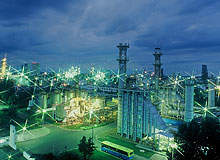
The Petrobrazi crude oil refinery in Romania is situated near Ploiesti in Prahova County. It is owned by OMV Petrom.
The capacity of the refinery was 4.5 million tons per annum (mtpa) which was increased to 4.2mtpa as part of a modernisation programme.
The modernisation was completed in September 2014.
Output
The refinery produces gasoline, diesel, aviation fuel Jet A-1, automotive liquefied petroleum gas (LPG), heavy fuel oil, LPG-aragaz and light fuel oil. It also produces benzene, toluene, propylene and special products, including sulphur and petroleum coke.
Extensions / developments
OMV Petrom planned the 2010-2015 modernisation programme at a cost of more than €1bn to increase the capacity of refinery to 6mtpa. The programme was, however, downsized due to poor market conditions. The extension was reduced to 4.2mtpa from the planned 6mtpa. As a result, the investment was reduced to €600m and the programme was completed in September 2014.
The project scope included modernisation of the vacuum and atmospheric distillation unit, increase of VGO conversion capacity, coker unit revamp, DGRS modernisation, reducing SOx and NOx emissions, and building a new hydrocracker unit.
Foster Wheeler was awarded a contract in April 2010 for the front-end engineering design (FEED) modification services, overhaul of the vacuum and atmospheric distillation unit, and expansion of the delayed coker unit.
The extended refinery features an 860MW gas-fired combined cycle power plant (CCPP) to generate electricity using natural gas. The natural gas is supplied through an underground pipeline built at Butimanu, Dambovita County. It is envisaged that approximately 20% of the power is consumed by the refinery and the remaining is transmitted to the National Grid.
Construction of the power plant began in December 2008.
Connection
Crude oil from Petrom’s oil fields is transferred to the refinery through pipeline connections. The crude imported from Kazhkstan is first stored at Constanta Oil Terminal and then transferred to the refinery through a pipeline with a capacity of 10,000tpd.
Design
The refinery is designed to process heavy vacuum gas oil with 86% conversion capability. The products meet the global emission standards of Euro V, which facilitates the plant to access global markets. It also aids in upgrading the plant with further investments when the country adopts global emission standards.
Construction and infrastructure
Built on a 520ha industrial site, the refinery was commissioned in 1934. In 1962, it became the first Romanian refinery to be installed with catalytic cracking and reforming processes. A petrochemical complex was added in 1965. The diesel hydrotreating unit revamp was set-up in 2007.
A hydro-sulphur extraction equipment was installed at a €5m investment in April 2008. The refinery has a partial transition hydrocracking unit, a fluid catalytic cracker, coker unit and a naptha isomerisation unit.
A €34m refurbishment project began in 2009. It included refurbishment of API separators, reforming of biological treatment through new measurement equipment and renovation of sewerage system.
Uhde started the construction of the fluid catalytic cracker (FCC) post-treatment plant at the Petrobrazi Refinery in 2008 to reduce sulphur content in gasoline production.
The FCC plant was commissioned in March 2009 at a cost of €90m. It produces 700,000t of Euro V gasoline a year.
Technology
Haldor Topsoe signed a contract with Petrom in December 2007 to install a 34,000 BPSD grassroots hydrocracker unit along with the hydrogen plant at the Petrobrazi refinery. Petrom selected the Haldor Topsoe’s hydrocracking technology as the optimised solution for raising production in the refinery.
The hydrocracking technology transforms heavy vacuum gasoil and heavy coker gas oil into superior quality diesel, gasoline, jet fuel and petrochemical products. Topsoe offers basic engineering design and technical services to the refinery.
Contractors
Falck provides fire-fighting services at the refinery.



